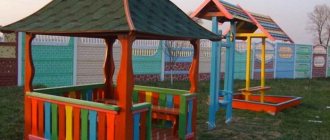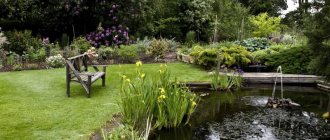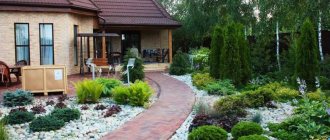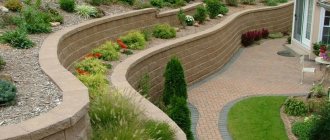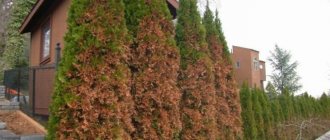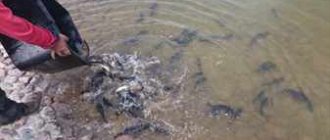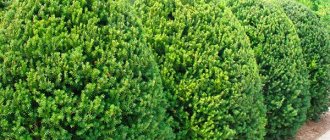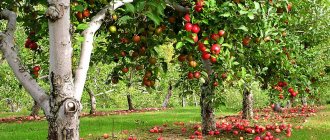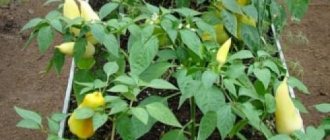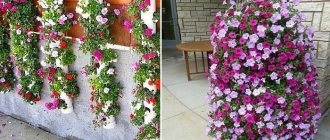Where is the best place to organize a kindergarten for a child?
The selected area should not be too large - a couple of flower beds or beds are enough. It is better if their size is small so that the baby can reach all the plants. For a children's garden or garden, a slightly shaded place, with good wind protection, on a flat area is suitable. It’s good if it is near the house, it will be visible from the windows: this way the young gardener will be able to watch his plants in any weather. If the site borders a road or a noisy street, it is better to lay out a children's garden or garden in the depths of the territory so that it is quiet and peaceful.
How to carry out landscaping?
Children like it when “their” territory is separated and clearly delineated, and therefore a low fence can be installed around the perimeter of the garden. If there is enough space in the allocated area, it is worth putting a bench or swing so that the baby can spend more time here. Experts recommend making paths paved or filled. The coating should not slip in wet weather, and soil should not fall on it. Flowerbeds or beds can be made raised and placed in boxes: this will make it easier for the baby to care for the plants. If the child will spend time in the garden after dark, it is worth providing street lighting. For a small area, installing solar-powered lights is sufficient. An automatic watering system is usually not needed: children love to water plants from watering cans.
It is desirable that the soil in the beds or flower beds be fertile and non-clayey: then the plants will grow better. To care for them, you can buy special children's equipment: small shovels, rakes, hoes, bright gardening gloves, a small watering can.
Do-it-yourself summer decoration of the preschool site
Master Class.
Decorating the territory of the kindergarten with figures and mosaics made from waste material. Author: Karpova Galina Nikolaevna, teacher of the Municipal Budget Educational Institution of the Moscow Region, Krasnodar “Center - Kindergarten No. 231” Description: The master class describes how to decorate the territory of the kindergarten with figures made from waste material, using mosaics from plastic bottle caps.

With such figures you can decorate both the school site and the dacha. School-age children can also be involved in creativity, for example, in a summer camp. Initially, the idea of two art projects arose. The first is near the main entrance to the kindergarten, with the code name “Magic Garden”, the second - “Sea Kingdom” - at the entrance to the nursery. Later, when our “magic garden” began to slowly take shape, it turned out that we also needed to do something with the terrace wall. This is how our third art project appeared - “Tales of A.S. Pushkin.” We tinkered with it longer than we thought, because as we worked, more and more new ideas arose, and in fact, even now everything is not finished. Therefore, our “Sea Kingdom” remains in sketches for now. What did we need to bring our ideas to life? Of course, the caps themselves, and a lot of them. Therefore, we began our work on projects by posting an announcement at the entrance to the kindergarten for parents, in which they asked to bring plastic lids of any color and size to the garden. And they, of course, actively supported us, and soon the workshop was filled with mountains of caps that had to be washed and sorted by size, color and shade.
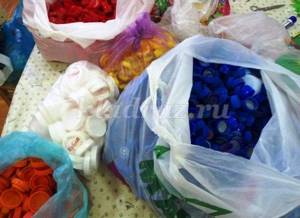
While the washed lids were drying, the base and stands were prepared. As a basis for the magic flowers, we used discarded lids from large pots, fan grilles, and lids from plastic paint buckets. And the base for the sunflower was the top of a plastic table. The stands—the “stems”—are discarded broken mops. All of the above “wealth” was provided to us by our caretaker Irina Nikolaevna, for which we thank her very much. All covers and grilles were washed, cleaned and painted. The racks were also painted green. Then we glued the caps with titanium glue. The finished figures were dug into the site. Later, birds were added to the flowers. Our carpenter cut the plywood base according to my drawing. After sanding the edges with sandpaper, I painted the bird blanks on both sides.

I attached two stands to the resulting figures to make them look like paws.
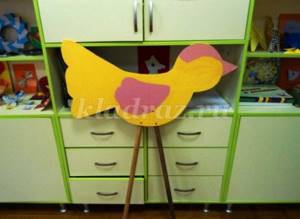
Then I started gluing the lids on.

These are the fairy-tale birds for the magical garden.
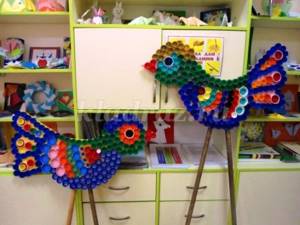
Now one has already flown up to the flower at the chosen place.

She also started working on the art project “Pushkin’s Tales” by drawing sketches. Having drawn the outline of the Swan Princess in chalk, I made an underpainting with white acrylic paint. When the paint was dry, I glued the caps on.
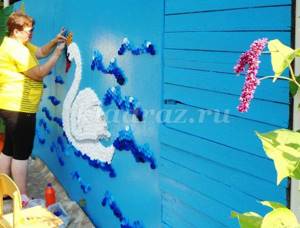
I made Buyan Island and the boat in the same way. The oak tree with the golden chain and the learned cat is almost ready. And the plans include a squirrel with a crystal house, a gold fish, and many more interesting ideas. For example, I wanted to add insects to the “Magic Garden”: butterflies, ladybugs. There is an idea to lay out the emblem of our garden with such a mosaic. So there is still a lot of work ahead.
We recommend watching:
Summer design of a preschool site with your own hands Summer design of a site with your own hands in a kindergarten Summer design of a sandbox with your own hands Summer design of a site with your own hands in a kindergarten
Similar articles:
Crafts from plastic bottles for kindergarten
What plants can be planted in kindergarten?
When choosing them, it is better to take into account the interests of the child. If he likes bright, beautiful flowers, you can plant decorative annuals and biennials. It is not advisable to use only perennial flowers: the garden must change so that the child is interested in working in it. Ornamental plants are selected according to flowering periods, so that some flowers replace others. Then, throughout the summer, the baby will be able to watch how the buds set and bloom, how fruits or new inflorescences appear in place of flowers.
In kindergarten you can also grow garden crops. It is better to choose those whose fruits the baby will eat with pleasure. At the same time, plants should not be too difficult to care for. Greens (leaf lettuce, dill, parsley), cucumbers (it is better to choose early-ripening varieties), green peas, beans, strawberries, wild strawberries are well suited. If there is enough space, you can plant fruit bushes - currants, gooseberries, blackberries, raspberries. It is better to choose varieties without thorns on the shoots, and not allow the bushes themselves to grow, so that caring for them and picking berries does not become too difficult.
Large plants are rarely planted in a child’s garden. Usually this is only one tree. A good idea is to choose a seedling whose age matches the baby's age and watch it grow along with its little owner.
If the baby has his own indoor plants, in the summer they can “move” to the open air, to the garden. To do this, you need to provide places where the pots will stand. It is advisable to place indoor species with good protection from the wind and moderate lighting.

Play surface and sand
Previously, kindergartens used river sand as a surface for playgrounds.
It is soft enough to prevent injury from accidental falls and can be used as a game attribute. However, such material is liked not only by children, but also by numerous animals that use it as a latrine, which is a direct violation of sanitary standards and can lead to diseases.
The design of the kindergarten site in the summer should completely exclude sand for playing. Instead, it is better to use a specialized rubber material that softens falls well and does not attract animals.
If sandboxes are used for play, they must be equipped with special lids that must be closed when the playground is left unattended.
Another important detail is the equipment for playing, which is mandatory in every kindergarten.
How to get your child interested in gardening?
By growing plants on his own, the child gains new knowledge, learns to treat all living things with care, and to be responsible. To make such activities interesting and their results impressive, the child will need the help of parents:
- start with seedlings. At the end of winter and early spring, children want to see greenery as soon as possible, and the appearance of sprouts in pots is especially impressive for them, since there is still snow outside. To interest your child, you can prepare containers and soil together, sow seeds for seedlings, and grow young plants;
- listen to your child when organizing his garden. If he wants to see flowering flower beds here, he should not insist on growing radishes, and vice versa. The child should feel that the garden belongs to him, that he decides what it will be like - this will help maintain interest;
- Praise more often. Tell your family and friends about your child’s success in gardening, take “excursions” to his garden, and often tell your child that he is doing an excellent job of caring for plants. If he gets tired quickly or something goes wrong, there is no need to scold him - because of this, the baby will cease to be interested in the garden. Don't insist that he does all the work himself: try to care for the garden together. If a preschooler is gardening, it is better to choose the most undemanding species: those that will not die if you forget to water them or weed the garden bed.
Children's garden beds or flower beds can “grow” with the child: if gardening turns out to be interesting for him, the space of his garden can be gradually increased and supplemented with plants that are more difficult to grow.
